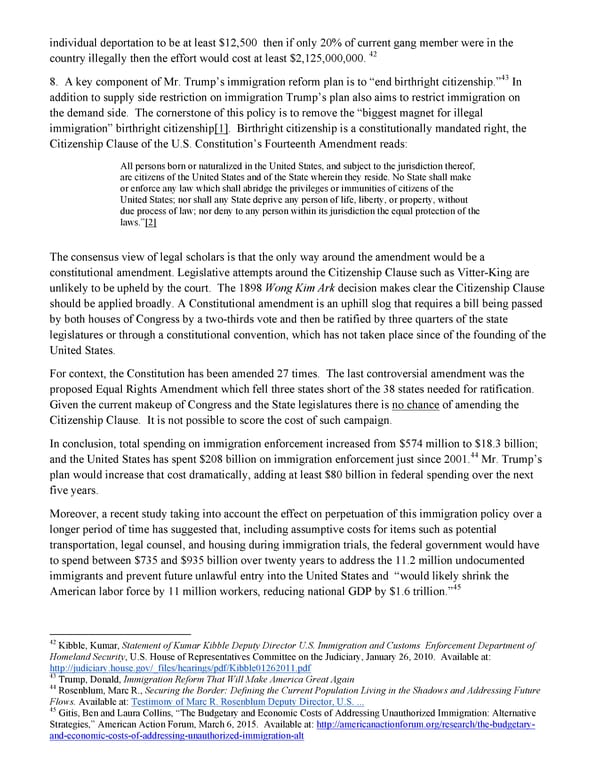individual deportation to be at least $12,500 then if only 20% of current gang member were in the 42 country illegally then the effort would cost at least $2,125,000,000. 43 8. A key component of Mr. Trump’s immigration reform plan is to “end birthright citizenship.” In addition to supply side restriction on immigration Trump’s plan also aims to restrict immigration on the demand side. The cornerstone of this policy is to remove the “biggest magnet for illegal immigration” birthright citizenship[1]. Birthright citizenship is a constitutionally mandated right, the Citizenship Clause of the U.S. Constitution’s Fourteenth Amendment reads: All persons born or naturalized in the United States, and subject to the jurisdiction thereof, are citizens of the United States and of the State wherein they reside. No State shall make or enforce any law which shall abridge the privileges or immunities of citizens of the United States; nor shall any State deprive any person of life, liberty, or property, without due process of law; nor deny to any person within its jurisdiction the equal protection of the laws.”[2] The consensus view of legal scholars is that the only way around the amendment would be a constitutional amendment. Legislative attempts around the Citizenship Clause such as Vitter-King are unlikely to be upheld by the court. The 1898 Wong Kim Ark decision makes clear the Citizenship Clause should be applied broadly. A Constitutional amendment is an uphill slog that requires a bill being passed by both houses of Congress by a two-thirds vote and then be ratified by three quarters of the state legislatures or through a constitutional convention, which has not taken place since of the founding of the United States. For context, the Constitution has been amended 27 times. The last controversial amendment was the proposed Equal Rights Amendment which fell three states short of the 38 states needed for ratification. Given the current makeup of Congress and the State legislatures there is no chance of amending the Citizenship Clause. It is not possible to score the cost of such campaign. In conclusion, total spending on immigration enforcement increased from $574 million to $18.3 billion; 44 and the United States has spent $208 billion on immigration enforcement just since 2001. Mr. Trump’s plan would increase that cost dramatically, adding at least $80 billion in federal spending over the next five years. Moreover, a recent study taking into account the effect on perpetuation of this immigration policy over a longer period of time has suggested that, including assumptive costs for items such as potential transportation, legal counsel, and housing during immigration trials, the federal government would have to spend between $735 and $935 billion over twenty years to address the 11.2 million undocumented immigrants and prevent future unlawful entry into the United States and “would likely shrink the 45 American labor force by 11 million workers, reducing national GDP by $1.6 trillion.” 42 Kibble, Kumar, Statement of Kumar Kibble Deputy Director U.S. Immigration and Customs Enforcement Department of Homeland Security, U.S. House of Representatives Committee on the Judiciary, January 26, 2010. Available at: http://judiciary.house.gov/_files/hearings/pdf/Kibble01262011.pdf 43 Trump, Donald, Immigration Reform That Will Make America Great Again 44 Rosenblum, Marc R., Securing the Border: Defining the Current Population Living in the Shadows and Addressing Future Flows. Available at: Testimony of Marc R. Rosenblum Deputy Director, U.S. ... 45 Gitis, Ben and Laura Collins, “The Budgetary and Economic Costs of Addressing Unauthorized Immigration: Alternative Strategies,” American Action Forum, March 6, 2015. Available at: http://americanactionforum.org/research/the-budgetary- and-economic-costs-of-addressing-unauthorized-immigration-alt
 THE $900 BILLION QUESTION: ILLEGAL IMMIGRATION Page 11 Page 13
THE $900 BILLION QUESTION: ILLEGAL IMMIGRATION Page 11 Page 13